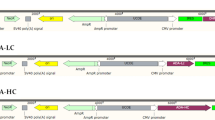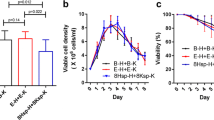Abstract
Recombinant human antibody production represents a major growing class of biopharmaceuticals based on the technological progress within the last decades especially in CHO cells. The HIV neutralizing human monoclonal antibody 2F5 was developed as hybridoma from human lymphocyte preparations. In order to estimate the potential of recombinant 2F5-expressing CHO cells, we generated different recombinant CHO cell lines by varying regulatory sequences, the codon usage, the signal peptides, and the transfection technique. These 2F5-expressing cell lines were developed by selection of the best producer, clone homogeneity, and clone stability. The gene copy number of the clones differed significantly due to methotrexate amplification. In one cell line, we identified only one copy of heavy chain and two copies of light chain. Neither the gene copy number nor the promoter was found to influence the amount of transcript exclusively emphasizing the positioning effect of the transgene. Messenger RNA levels were highest in 2F5/CO and may have resulted from a combination of the promoter and codon-optimized sequences, but unexpectedly, the amount of secreted product was not elevated in this configuration. In our example, translational and post-translational limitations are responsible for decreased antibody secretion.



Similar content being viewed by others
References
Alt FW, Kellems RE, Bertino JR, Schimke RT (1978) Selective multiplication of dihydrofolate reductase genes in methotrexate-resistant variants of cultured murine cells. J Biol Chem 253(5):1357–1370
Andersen DC, Krummen L (2002) Recombinant protein expression for therapeutic applications. Curr Opin Biotechnol 13(2):117–123
Barnes LM, Dickson AJ (2006) Mammalian cell factories for efficient and stable protein expression. Curr Opin Biotechnol 17(4):381–386
Barnes LM, Bentley CM, Dickson AJ (2004) Molecular definition of predictive indicators of stable protein expression in recombinant NS0 myeloma cells. Biotechnol Bioeng 85(2):115–121
Bentley KJ, Gewert R, Harris WJ (1998) Differential efficiency of expression of humanized antibodies in transient transfected mammalian cells. Hybridoma 17(6):559–567
Birch JR, Racher AJ (2006) Antibody production. Adv Drug Deliv Rev 58(5–6):671–685
Borth N, Strutzenberger K, Kunert R, Steinfellner W, Katinger H (1999) Analysis of changes during subclone development and ageing of human antibody-producing heterohybridoma cells by northern blot and flow cytometry. J Biotechnol 67(1):57–66
Boussif O, Lezoualch F, Zanta MA, Mergny MD, Scherman D, Demeneix B, Behr JP (1995) A versatile vector for gene and oligonucleotide transfer into cells in culture and in vivo: polyethylenimine. Proc Natl Acad Sci USA 92(16):7297–7301
Buchacher A, Predl R, Strutzenberger K, Steinfellner W, Trkola A, Purtscher M, Gruber G, Tauer C, Steindl F, Jungbauer A et al (1994) Generation of human monoclonal antibodies against HIV-1 proteins; electrofusion and Epstein–Barr virus transformation for peripheral blood lymphocyte immortalization. AIDS Res Hum Retroviruses 10(4):359–369
Darzacq X, Singer RH, Shav-Tal Y (2005) Dynamics of transcription and mRNA export. Curr Opin Cell Biol 17(3):332–339
Derouazi M, Girard P, Van Tilborgh F, Iglesias K, Muller N, Bertschinger M, Wurm FM (2004) Serum-free large-scale transient transfection of CHO cells. Biotechnol Bioeng 87(4):537–545
Dinnis DM, James DC (2005) Engineering mammalian cell factories for improved recombinant monoclonal antibody production: lessons from nature? Biotechnol Bioeng 91(2):180–189
Fiering S, Whitelaw E, Martin DI (2000) To be or not to be active: the stochastic nature of enhancer action. Bioessays 22(4):381–387
Flickinger MC, Goebel NK, Bibila T, Boyce-Jacino S (1992) Evidence for posttranscriptional stimulation of monoclonal antibody secretion by L-glutamine during slow hybridoma growth. J Biotechnol 22(3):201–226
Fussenegger M, Bailey JE (1998) Molecular regulation of cell-cycle progression and apoptosis in mammalian cells: implications for biotechnology. Biotechnol Prog 14(6):807–833
Graham FL, van der Eb AJ (1973) A new technique for the assay of infectivity of human adenovirus 5 DNA. Virology 52(2):456–467
Hooker AD, Green NH, Baines AJ, Bull AT, Jenkins N, Strange PG, James DC (1999) Constraints on the transport and glycosylation of recombinant IFN-gamma in Chinese hamster ovary and insect cells. Biotechnol Bioeng 63(5):559–572
Jiang Z, Huang Y, Sharfstein ST (2006) Regulation of recombinant monoclonal antibody production in chinese hamster ovary cells: a comparative study of gene copy number, mRNA level, and protein expression. Biotechnol Prog 22(1):313–318
Kim NS, Kim SJ, Lee GM (1998a) Clonal variability within dihydrofolate reductase-mediated gene amplified Chinese hamster ovary cells: stability in the absence of selective pressure. Biotechnol Bioeng 60(6):679–688
Kim SJ, Kim NS, Ryu CJ, Hong HJ, Lee GM (1998b) Characterization of chimeric antibody producing CHO cells in the course of dihydrofolate reductase-mediated gene amplification and their stability in the absence of selective pressure. Biotechnol Bioeng 58(1):73–84
Knappskog S, Ravneberg H, Gjerdrum C, Trosse C, Stern B, Pryme IF (2007) The level of synthesis and secretion of Gaussia princeps luciferase in transfected CHO cells is heavily dependent on the choice of signal peptide. J Biotechnol 128(4):705–715
Kohl J, Ruker F, Himmler G, Razazzi E, Katinger H (1991) Cloning and expression of an HIV-1 specific single-chain Fv region fused to Escherichia coli alkaline phosphatase. Ann N Y Acad Sci 646:106–114
Kunert R, Ruker F, Katinger H (1998) Molecular characterization of five neutralizing anti-HIV type 1 antibodies: identification of nonconventional D segments in the human monoclonal antibodies 2G12 and 2F5. AIDS Res Hum Retroviruses 14(13):1115–1128
Lattenmayer C, Trummer E, Schriebl K, Vorauer-Uhl K, Mueller D, Katinger H, Kunert R (2007) Characterisation of recombinant CHO cell lines by investigation of protein productivities and genetic parameters. J Biotechnol 128(4):716–725
Lee TI, Young RA (2000) Transcription of eukaryotic protein-coding genes. Annu Rev Genet 34:77–137
Loyter A, Scangos GA, Ruddle FH (1982) Mechanisms of DNA uptake by mammalian cells: fate of exogenously added DNA monitored by the use of fluorescent dyes. Proc Natl Acad Sci USA 79(2):422–426
Miller WM, Blanch HW, Wilke CR (2000) A kinetic analysis of hybridoma growth and metabolism in batch and continuous suspension culture: effect of nutrient concentration, dilution rate, and pH. Biotechnol Bioeng 67(6):853–871 (Reprinted from Biotechnology and Bioengineering 32:947–965, 1988)
Narum DL, Kumar S, Rogers WO, Fuhrmann SR, Liang H, Oakley M, Taye A, Sim BK, Hoffman SL (2001) Codon optimization of gene fragments encoding Plasmodium falciparum merzoite proteins enhances DNA vaccine protein expression and immunogenicity in mice. Infect Immun 69(12):7250–7253
Pendse GJ, Karkare S, Bailey JE (1992) Effect of cloned gene dosage on cell growth and hepatitis B surface antigen synthesis and secretion in recombinant CHO cells. Biotech Bioeng 40(1):119–129
Reisinger H, Sevcsik E, Vorauer-Uhl K, Lohner K, Katinger H, Kunert R (2007) Serum-free transfection of CHO-cells with tailor-made unilamellar vesicles. Cytotechnology 54:157–168
Rutkowski DT, Kaufman RJ (2004) A trip to the ER: coping with stress. Trends Cell Biol 14(1):20–28
Shaffer AL, Shapiro-Shelef M, Iwakoshi NN, Lee AH, Qian SB, Zhao H, Yu X, Yang L, Tan BK, Rosenwald A et al (2004) XBP1, downstream of Blimp-1, expands the secretory apparatus and other organelles, and increases protein synthesis in plasma cell differentiation. Immunity 21(1):81–93
Strutzenberger K, Borth N, Kunert R, Steinfellner W, Katinger H (1999) Changes during subclone development and ageing of human antibody-producing recombinant CHO cells. J Biotechnol 69(2–3):215–226
Urlaub G, Chasin LA (1980) Isolation of Chinese hamster cell mutants deficient in dihydrofolate reductase activity. Proc Natl Acad Sci USA 77(7):4216–4220
Verrijzer CP, Chen JL, Yokomori K, Tjian R (1995) Binding of TAFs to core elements directs promoter selectivity by RNA polymerase II. Cell 81(7):1115–1125
Wurm FM (2004) Production of recombinant protein therapeutics in cultivated mammalian cells. Nat Biotechnol 22(11):1393–1398
Acknowledgments
This research was part of the Pharma-Planta Project (LSHB-CT-2003–503565), kindly funded by an EU FP6 program and partly supported by Polymun Scientific GmbH.
Author information
Authors and Affiliations
Corresponding author
Rights and permissions
About this article
Cite this article
Reisinger, H., Steinfellner, W., Stern, B. et al. The absence of effect of gene copy number and mRNA level on the amount of mAb secretion from mammalian cells. Appl Microbiol Biotechnol 81, 701–710 (2008). https://doi.org/10.1007/s00253-008-1701-1
Received:
Revised:
Accepted:
Published:
Issue Date:
DOI: https://doi.org/10.1007/s00253-008-1701-1




